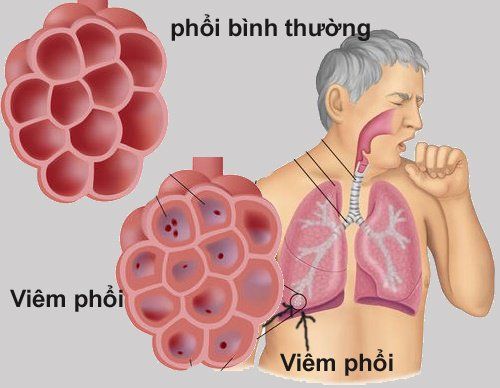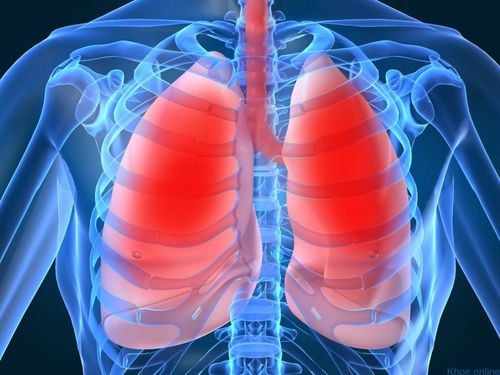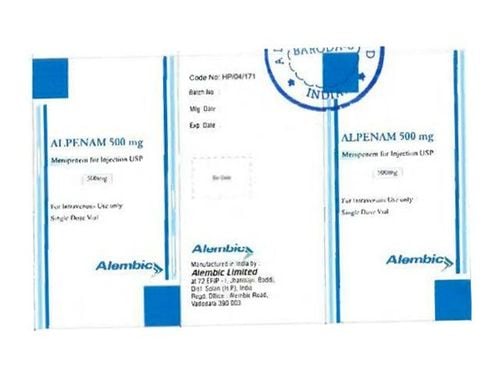This is an automatically translated article.
The article is professionally consulted by Master, Doctor Nguyen Huy Nhat - Department of Medical Examination & Internal Medicine - Vinmec Da Nang International General Hospital.
Nosocomial pneumonia is the most common nosocomial infection and the leading cause of death in nosocomial infections. Studies show that the mortality rate of hospital-acquired pneumonia is very high, ranging from 20-70%. So what is hospital-acquired pneumonia and what are its characteristics?
1. What is nosocomial pneumonia?
In fact, nosocomial pneumonia is pneumonia that occurs in a patient 48 hours or more after being admitted to the hospital, without being in the incubation period or having the disease at the time of admission.This is a very difficult problem that clinical departments, especially the intensive care unit have to deal with because of the difficulty in diagnosis, treatment and prevention. According to research, hospital-acquired pneumonia in developed countries accounts for 15% of all hospital-acquired infections and 27% of hospital-acquired infections in ICUs.
In cases of hospital-acquired pneumonia, ventilator-associated hospital-acquired pneumonia was determined after 48 hours or more of mechanical ventilation, accounting for 90% of the time, prolonging the hospital stay and being costly. treatment. In Vietnam, scientists also noted that hospital-acquired pneumonia accounts for about 21% to 75% of total hospital infections; in which ventilator-associated hospital-acquired pneumonia accounted for a particularly high rate in the group of patients treated in the intensive care unit.
2. The causative agent of hospital-acquired pneumonia
These agents can vary from hospital to hospital, geographically due to different pathogens and diagnostic methods.Nosocomial pneumonia caused by a variety of bacteria, usually Gram-negative aerobic bacteria such as Pseudomonas aeruginosa, Acinetobacter spp, Klebsiella spp, Enterobacter spp, E coli, Providencia spp; Gram-positive bacteria such as Staphylococcus aureus and Streptococcus pneumonia also account for a high percentage. These bacteria are often multi-drug resistant, making treatment difficult. The causative agent of ventilator-associated hospital-acquired pneumonia that appears early (less than 4 days) is usually caused by microorganisms that are less resistant to antibiotics, but if it occurs later, it is often caused by multidrug-resistant microorganisms. Studies have shown that the bacteria that cause early ventilator-associated pneumonia are usually caused by Enterobacteriaceae spp., methicillin-susceptible Staphylococcus aureus (MRSA), and Haemophilus influenza. Late pneumonia is usually caused by Acinetobacter baumannii and MRSA. The causative agent is also different in different departments.

3. Source of entry of pathogenic microorganisms
In fact, microorganisms enter the lungs from oropharyngeal secretions, refluxed gastric juices, respiratory support devices or the hands of healthcare workers and family members caring for sick patients. pollution, blood sugar.Respiratory support devices such as oxygen humidifiers, nebulizers, bronchoscopes, spirometers, anesthetic tools... are reservoirs of bacteria. The mechanism of infection can be from instrument to patient, from patient to patient, from one body site to the lower respiratory tract of the same patient through hands or through instruments.
Ambu balls that help with breathing can also be a source of bacteria entering the patient's lungs through each squeeze because the balls are difficult to clean and dry between uses. The ball is also likely to become infected through the hands of medical staff. Therefore, it is necessary to reduce the risk of infection from reused medical instruments by properly washing, disinfecting and sterilizing them.
Ventilators using humidification are a source of bacteria that cause hospital-acquired pneumonia in ventilator patients. Water that settles in the pipe and collects in the water trap can quickly become contaminated with bacteria from the patient's mouth and pharynx. Therefore, it is necessary to drain the water well in the pipeline to avoid causing hospital-acquired pneumonia because contaminated water in the pipeline flows into the patient's lungs.
Nebulizers are often used to spray bronchodilators and corticosteroids, which is also a source of hospital-acquired pneumonia because the machine is infected through the hands of medical staff, the part containing the drug is infected because it is not disinfected. appropriate bacteria between uses.
4. Risk factors for hospital-acquired pneumonia

Patient-related factors:
Newborns, elderly people over 65 years old, obese people; patients with abdominal, chest, head and neck surgery; patients with severe comorbidities such as pulmonary dysfunction (such as chronic obstructive pulmonary disease, thoracic abnormalities, abnormal lung function), immunosuppression, loss of cough-swallowing reflex; Patients with coma, difficulty swallowing due to diseases of the nervous system or esophagus increase the risk of aspiration pneumonia; Factors that increase bacterial colonization and colonization. Medical intervention factors:
Intubation or tracheostomy diseases; Placing a nasogastric tube: The catheter is a place to increase parasitic microorganisms in the nose and pharynx, causing reflux of gastric juice, bacteria from the stomach through the tube to the upper respiratory tract; Conditions that favor reflux or aspiration pneumonia: eg intubation, nasogastric tube, or supine position; Conditions requiring prolonged mechanical ventilation: This condition increases the risk of contact with contaminated instruments, contaminated hands of healthcare workers; Factors that interfere with sputum production: Such as head, neck, chest, and abdominal surgery, immobilization due to injury or illness, sedation or coma; Patients receiving gastric antacids to prevent gastrointestinal bleeding due to stress have a higher risk of nosocomial pneumonia than patients receiving sucralfate prophylaxis; Enteral feeding can cause bacterial cross-contamination through the preparation of the solution and cause gastric pH to rise, in addition, reflux and aspiration pneumonia are more likely to occur in the stomach. increase in volume and pressure. Environmental factors, tools:
Transmission of hospital-acquired pneumonia-causing bacteria such as Gram-negative bacilli and staphylococci through contaminated medical staff's hands through manipulations such as suction of sputum, handling ventilator wire, into the endotracheal tube; Transmission of microorganisms that cause hospital-acquired pneumonia through instruments that are not properly disinfected - sterilized; Transmission of nosocomial pneumonia-causing microorganisms through the air, through contaminated surfaces.
5. Symptoms of hospital-acquired pneumonia
Hospital-acquired pneumonia has typical symptoms of community-acquired pneumonia such as fever, cough, purulent sputum, shortness of breath, and coagulation syndrome.However, the clinical presentation of pneumonia is often overshadowed by other diseases (eg, toxicity, drug allergy, atelectasis, pulmonary infarction, respiratory distress syndrome in adults, congestive heart failure, etc.) tracheobronchitis). In addition, fluid sucked into the lungs from the stomach... also causes pneumonia, so it is difficult to distinguish from bacterial pneumonia.
6. Prevention of hospital-acquired pneumonia

Organization, training and professional training, implementation of periodic inspection and supervision period or when there is an epidemic of hospital-acquired pneumonia; Sterilization and sterilization of respiratory support tools, including: Instruments related to mechanical ventilation and respiratory support, tools related to aerosol breathing, tools related to anesthesia machines; Prevention of infection by medical staff, proper care of comatose patients to prevent pneumonia caused by inhaling pathogens; Take care of patients with intubation, tracheostomy and other supportive artificial ventilation in accordance with regulations; Take good care of the patient's respiratory tract in the postoperative period; Sanitize hands before and after contact with the sick person and any breathing apparatus being used on the sick person; Clean the patient's teeth with a brush twice a day or with gauze every 2-4 hours with an antiseptic solution; Remove the endotracheal tube, tracheostomy tube, feeding tube, and consider discontinuing the patient's ventilator as soon as possible when indicated; Have the patient lie with the head elevated at an angle of 30 to 45 degrees if there are no contraindications; Should regularly check and pour residual water in ventilator pipes, trap water used for patients; Disposable respiratory care equipment or high-level sterilization or disinfection should be used for re-usable patient equipment; The breathing line must be positioned lower than the upper part of the endotracheal tube; Regularly check for gastric stasis before feeding the patient through the tube. Hospital-acquired pneumonia has the potential to lead to high mortality for patients, so the prevention of hospital-acquired pneumonia is an issue that should be taken seriously with the responsibility of medical staff, including patients' family members. participating in the treatment and care of patients.
Hospital pneumonia as well as respiratory diseases are examined and treated by a team of highly qualified and experienced doctors at Vinmec hospital. Including Master, Doctor Nguyen Huy Nhat with many years of experience in the field of respiratory disease treatment at Hue Central Hospital, Hoan My General Hospital, .. before being a doctor of General Internal Medicine Department. Vinmec Da Nang International General Hospital.
Please dial HOTLINE for more information or register for an appointment HERE. Download MyVinmec app to make appointments faster and to manage your bookings easily.














